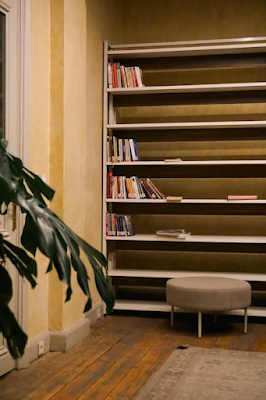Interior design is both a science and an art. Professional interior designers typically adhere to a set of informal principles to craft captivating spaces, known as the Seven Elements of Interior Design. Understanding these elements and their dynamics can empower you to enhance any space. The accompanying image, expertly crafted by Harrods, serves as a prime illustration of these essential elements in action.
Seven holds a certain allure, especially in the realm of interior design. If you've hit a creative roadblock in home décor, exploring these seven elements and principles can ignite fresh inspiration. Rediscovering the fundamentals might unveil surprising insights into transforming your living spaces. Dive in to discover the transformative potential for yourself!
 |
| The finest illustration of incorporating the seven elements. |
What Comprise the Seven Fundamental Elements of Interior Design?
COLOR
Color plays a pivotal role in defining a room's ambiance and setting its mood. It possesses the remarkable ability to evoke emotions, stir memories, and inspire feelings. For instance, green and blue evoke a sense of peace and tranquility, while also imparting a calming effect. Purple signifies luxury and mystery, and brown exudes warmth and homeliness.
FORM
Form, also known as shape, encompasses the contours of artwork, furniture, or any decorative element imaginable. It delineates both the overall shape of the room and its furnishings. Balance and organic shapes are central to form. Furniture, lighting, and even flooring can embody two distinct forms: natural shapes and geometric forms. Natural shapes exhibit genuine irregularity, often characterized by curvaceous or abstract contours. In contrast, geometric forms feature precise, man-made lines and edges, projecting a bold aesthetic. While geometric shapes exude boldness, natural forms impart a softer, more organic appearance.
LIGHT
The significance of lighting in shaping our perception is evident when we recoil at poorly lit photographs. Lighting, whether natural or artificial, singularly or combined, profoundly impacts any space's ambiance and functionality.
LINE
Line in interior design serves as the boundary surrounding forms or shapes, akin to outlining an object when drawing. These lines not only provide structure but also establish directionality within the space, guiding the viewer's gaze towards focal points.
PATTERN
Patterns intentionally replicate forms, lines, or other elements within interior design, injecting intrigue and vitality into a room. Typically found on wallpapers or fabrics, patterns can emerge anywhere within the home, including light fixtures and other design elements. Offering a visual richness, patterns span a spectrum of styles, from abstract and floral to geometric shapes, adding depth and character. While patterns infuse dynamism and energy into a space, excessive clashes can create visual discord, underscoring the importance of thoughtful selection.
In concert with colors, patterns enhance a room's allure, appearing across various surfaces like cushions, ceilings, staircases, and curtains. Serving as a collection of lines and forms, patterns breathe life into the space, augmenting its visual appeal and atmosphere.
TEXTURE
Distinguishing itself from pattern, texture pertains to the tactile sensation an object elicits. It encompasses both the physical feel of an object when touched (physical texture) and the impression it imparts when visually observed (visual texture). For instance, a surface may exude a "weathered" or "vintage" appearance without requiring physical contact, owing to the strategic incorporation of texture.
Mindful attention to texture holds particular significance in areas of the home frequently interacted with, such as flooring. Our team at Flooring America is poised to assist you in selecting flooring options boasting the ideal, inviting texture to set a positive tone for each day.
Often overlooked, texture encompasses both the appearance and tactile quality of an object or surface. Textures like glossy, smooth, or coarse contribute depth and intrigue to a space. While physical texture pertains to the tactile feel of materials such as silk or linen, visual texture, like stone wallpaper, creates the illusion of texture, infusing a rustic charm into the room's ambiance.
SPACE
Finally, space stands as a cornerstone of virtually every design endeavor. Understanding the two fundamental types of space is imperative: 2-D space, which encompasses a room's length and width, and 3-D space, which extends to its height. Considerations vary depending on the dimension: while 2-D space suffices for carpets or rugs, 3-D space comes into play when introducing new shelving or furniture. Achieving equilibrium between positive and negative space is equally crucial. Positive space denotes areas occupied by furnishings and décor, whereas negative space remains unadorned.
This pivotal aspect of interior design is categorized into positive and negative space. Positive space is occupied by furniture and objects, while negative space remains vacant. Various design styles leverage space differently; minimalist approaches typically embrace more negative space. The challenge lies in striking a harmonious balance between the two, avoiding overcrowding or sparsity. This equilibrium is determined by the desired aesthetic and functional requirements of the space.
Ready to Create a Space that Reflects Your Unique Style?
Understanding the 7 elements of interior design – space, form, line, light, color, pattern, and texture – is a great starting point. But crafting a space that truly reflects your personality and fulfills your functional needs requires expertise.
At Ayla Design, we're passionate about creating beautiful and functional living spaces for San Jose residents. We'll guide you through the design process, considering all 7 elements to create a space that's:
- Functional and Efficient: We'll optimize your space to maximize flow and cater to your lifestyle needs.
- Stylish and Inviting: We'll help you develop a cohesive aesthetic that reflects your taste and personality.
- Comfortable and Welcoming: We'll create a space that feels like a sanctuary, promoting relaxation and enjoyment.
Contact Ayla Design today for a free consultation and let's discuss your vision! We'll take the time to understand your unique needs and preferences, and translate them into a living space you'll love.
Here's how to reach us:
- Schedule a Consultation: https://www.designbyayla.com/
We look forward to collaborating with you and transforming your dream space into a reality!
Email Us ✉️ INFO@DESIGNBYAYLA.COM
Call Us 📞 408 800 6972








Comments
Post a Comment